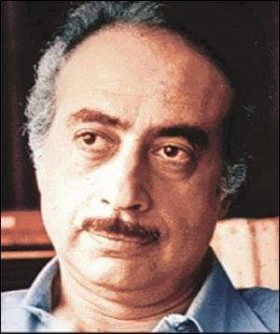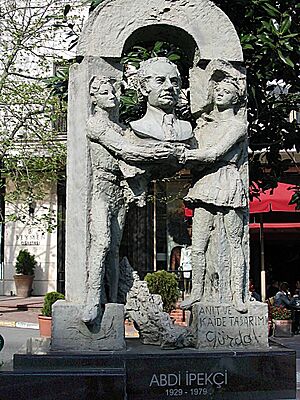Abdi İpekçi facts for kids
Quick facts for kids
Abdi İpekçi
|
|
|---|---|
 |
|
| Born | 9 August 1929 Istanbul, Turkey
|
| Died | 1 February 1979 (aged 49) İstanbul, Turkey
|
| Education | Galatasaray High School Istanbul University |
| Occupation | Editor-in-chief |
| Years active | 1954–1979 |
| Spouse(s) |
Afife Sibel Dilber
(m. 1956) |
| Children | Nukhet İpekçi (b. 1957)(daughter) Sedat İpekci (b. 1961) (son) |
| Relatives | İsmail Cem (1940–2007) (cousin) Cemil İpekçi (1948–) (cousin) |
Abdi İpekçi (born August 9, 1929 – died February 1, 1979) was a famous Turkish journalist. He was also known as an intellectual and a supporter of human rights. He was the main editor of Milliyet, a major Turkish daily newspaper. At that time, the newspaper had a political view that was slightly to the left.
Life Story
Abdi İpekçi was born in Istanbul, Turkey. He finished high school at Galatasaray High School in 1948. After that, he studied law for a while at Istanbul University.
He started his career as a sports reporter for a newspaper called Yeni Sabah. Later, he moved to another newspaper, Yeni İstanbul. In 1954, he joined Milliyet newspaper. He became its publishing manager. By 1959, he was promoted to the top job: editor-in-chief.
His Ideas and Beliefs
Abdi İpekçi was a highly respected journalist. He strongly believed that religion and government should be kept separate. He also worked hard to encourage peace and understanding with Greece. He was a big supporter of human rights for all minorities in Turkey.
İpekçi generally supported ideas and groups that leaned to the left in politics. He was known around the world as a moderate thinker. He often spoke out against extreme political views. These extreme views were causing a lot of violence in Turkey at the time.
His Murder
On February 1, 1979, Abdi İpekçi was murdered. He was in his car, driving home from his office in Istanbul. Two members of an extreme nationalist group called the Grey Wolves killed him. Their names were Oral Çelik and Mehmet Ali Ağca.
Mehmet Ali Ağca was caught because someone told the police. He was sentenced to life in prison. But after only six months, Ağca escaped from a military prison. He got help from some military officers and the Grey Wolves. He first fled to Iran and then to Bulgaria.
Ağca later became very famous for something else. He tried to assassinate Pope John Paul II on May 13, 1981. This attempt was not successful.
Abdi İpekçi was buried in the Zincirlikuyu Cemetery. He left behind his wife, Sibel, his daughter, Nükhet, and his son, Sedat.
How He is Remembered
The street where Abdi İpekçi lived and was murdered was renamed Abdi İpekçi Avenue. This was done to honor him. On February 1, 2000, a special statue was put up. It is near the spot where he was killed in Şişli.
The monument was designed by an architect named Erhan İşözen. The bronze sculpture is 3.5 meters tall. It stands on a granite base that is 0.70 meters high. The memorial shows İpekçi's head held by a male and a female student. A dove sits on top, which stands for peace.
There is also a large indoor sports arena in Istanbul named after him. It is called the Abdi İpekçi Arena.
The Ipekci Peace and Friendship Prize was created in 1981. This award honors people who help improve relations between Greece and Turkey. It is given out every two years, either in Athens or Istanbul. Famous winners include the writer Dido Sotiriou and the photographer Nikos Economopoulos.
In 2000, Abdi İpekçi was recognized as one of the International Press Institute's 50 World Press Freedom Heroes. This award honors journalists who have bravely defended press freedom.
See also
- List of assassinated people from Turkey


